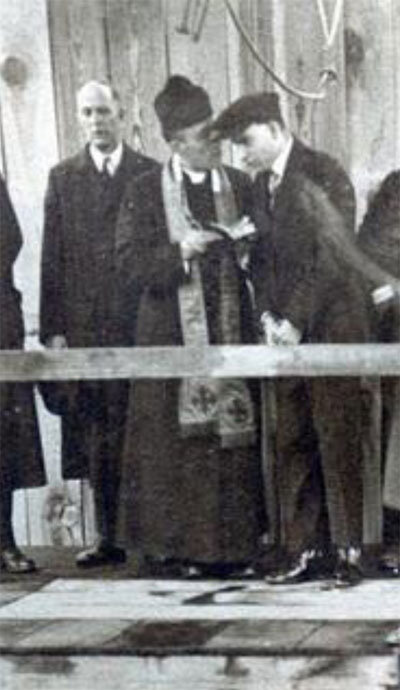Riot of 1920
West Frankfort IL in 1920 was made up of many different nationalities, Hungarians, Italians, French, and many more. Each had their own neighborhoods, usually at the outskirts of town. The Chinese had a laundry in town, and lived behind or above it. There were no Black people in Franklin County. If one were to pass through, they were sure to be out of the county before dark.
During the night of August 5, 1920, a mob of more than 3000 took over the town of West Frankfort threatening to drive out the foreign population. It had been fueled in part by factions and elements of the Sicilian mafia immigrating to the Egyptian Coal fields. A committee of citizens announced that a Black Hand Society of more than 200 members, with headquarters in West Frankfort, had been discovered.
The Black Hand Society, a branch of the Italian mafia, would send a letter with an imprint of a black hand as a warning to those reluctant to comply with their demands. Members of the Italian community and their American neighbors were forced to pay a portion of their wages to the Black Hand Society. Those who refused to pay found themselves and their family subject to harassment, beatings, and sometimes death.
The riot was attributed to thousands of idle coal miners who were on strike and a series of bank robberies, supposedly by a band of Italian bank robbers called the Black Hand Society. It escalated when two boys, Amel Calcaterra age 16, and Tony Hemphill age 19, were kidnapped and murdered.
The mutilated bodies were found buried in a woods south of Royalton by a hunter. Both were shot in the head and their throats cut from ear to ear. The discovery of their bodies touched off the civic explosion.
The rioting started after Settimi De Santis was arrested in conjunction with the murder and taken to the Marion jail. The mob stormed the jail, demanding the prisoner. After authorities refused their demand, the prisoner was hastily moved out of the city. The mob then divided and started searching nearby city jails. As a result of a telegram sent by Frank Bianco to Settimi DeSantis, Bianco was arrested at Columbus Ohio and also brought back to Marion.
Automobiles loaded with armed parties arrived in great numbers. The mob, determined to rid every foreigner from the area, surged through the streets beating any foreigner on sight, although the Italian population was the chief objective. Scores of armed rioters burst into the Italian district, dragging people of all ages and both sexes from their homes, clubbing and stoning them, and then setting fire to their dwellings. Some were taken into the woods, beaten and left on the ground. In some cases shots were fired. The Italians tried to fight back as best as they could, turning West Frankfort into a battleground.
Mayor Lon Fox and Sherriff Robert Watkins appealed to Governor Frank O. Lowden for troops, declaring the actions of the mob were beyond control of the local officials. Governor Lowden ordered 5 companies of the 9th Illinois Infantry to proceed at once to West Frankfort under the command of Major E. Satterfield of Mount Vernon. When Major Satterfield and the troops arrived they were notified by the sheriff that they were not needed. The 500 troops then withdrew from the city and camped in a school yard on the outskirts.
Peace was restored for a short time that morning, but mob violence broke out again in the afternoon. Major Satterfield took charge but only had enough men to control the main street, leaving the outlying sections unprotected. This resulted in Major Wilbur Satterfield wiring to Governor Lowden for 500 additional soldiers because the situation was very critical. Not only were the foreigners being attacked by the rioters, but also his soldiers.
To quell the riot, Adjutant General Dickson had ordered nine companies of 10th Infantry and four companies of the 7th Reserve to board a train for West Frankfort. Brigadier General Wells from Springfield had been ordered to take charge of the chaotic situation.
The Italian residences were warned to leave town within 24 hours or suffer the consequence. The rioters, according to the Italians, stole many of their belongings and did a considerable amount of damage while going from house to house with the warning.
The exodus started shortly after midnight, continuing all night with hundreds of foreigners seen on the highways making their way to other mining towns in Franklin and Williamson Counties. They left in automobiles, in horse-drawn vehicles and on foot loaded down with clothing and household goods. Many of them were also driving cattle and hogs before them.
The story of that night was one of anarchy. The mob disarmed the police and Deputy Sheriffs. Mayor Fox, Sheriff Watson and state’s Attorney Martin pleaded in vain for order. Communication with the outside world was almost nonexistent because of a telephone operators strike and the telegraph service being swamped. It took a message 24 hours to go from West Frankfort to Marion.
A school house in an Italian neighborhood was damaged by fire. Several Italians who arrived that morning by train were beaten and placed back on the train.
A pool hall run by an Italian and patronized by many of his countrymen was wrecked and burned. The mob believed that the band of robbers plotted their crimes there. The torch was applied to another building used as a clubhouse by Italians.
An Italian living in Zeigler was caught by a crowd on the street. It was reported that he had been there the night before to attend a meeting of an Italian society. The mob beat him and left him for dead. Another Italian was shot and his body left in the street.
A photographer from Valier, who attempted to take pictures of the riot, was knocked down, his camera smashed and then beaten to death, according to a message received at the Illinois Central office in Carbondale from the company’s telegraph station at West Frankfort.
The chaos went on for three days. When it was over hundreds of Italian- Americans were homeless, scores were injured and some killed. The loss from fire was estimated at tens of thousands of dollars.
On October 2, 1920, Settimi De Santis and Frank Bianco were indicted by a Williamson County grand jury for the murder of the two boys. The town of Royalton, where the bodies were found, was part of Williamson County at that time.
On December 6, 1920, the trial of Bianco and De Santis opened. It was brought out at the trial that the two boys were lured to Royalton by Settimi De Santis on pretense of helping Bianco buy an automobile. They were led south of Royalton where Frank Bianco shot them and then buried them in a shallow grave.
One motive for the killing was the desire of Frank Bianco to marry Amel Calcaterra’s sister, Rosa. De Santis was hired by Bianco to kill Marco Calcaterra, the husband of Rosa for $200. The death of Amel was plotted for the purpose of frightening Rosa and learning of her location Another motive that was shown, was the fact that Bianco was afraid Amel would tell about the robberies that he (Bianco) was connected with.
On December 10, 1920 Bianco hanged himself in the Williamson County jail. The trial of De Santis was continued without the jury being told of the suicide of Bianci. On December 12, 1920, the jury returned the verdict of death. On Friday February 11, 1921, Settimi De Santis was executed.
Information compiled from the following sources by Bob Maragni
The Story of Royalton by Mary Alyce Kern
Tribal twenties by John Higham
De Santis the Doomed – Published in 1921 by Herrin News
New York Times, August 6, 1920
Lewiston, Maine Daily Sun, August 6, 1920
Spokesman Review, Spokane, Washington, December 12, 1920
Kokomo Indiana Daily Tribune, December 13, 1920
New York Tribune, August 6, 1920
Toronto Canada World, August 6, 1920
Beaver, Pa. Daily Times, August 6, 1920

Father Seneese, a Catholic Priest from Herrin, gives Santis comfort before he was hanged.
